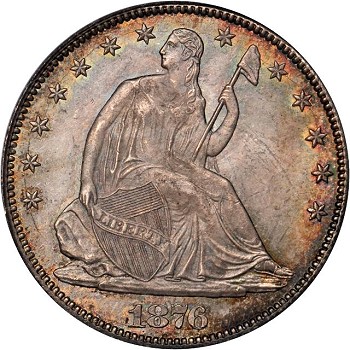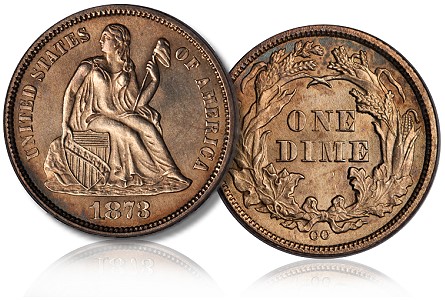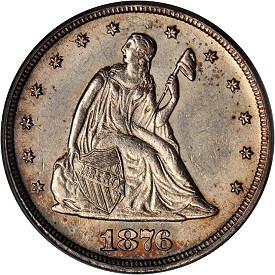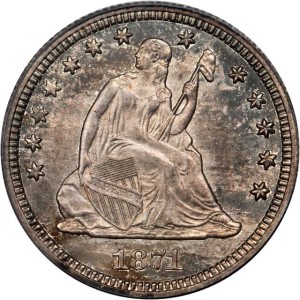A Weekly CoinWeek Column by Greg Reynolds
News and Analysis regarding scarce coins, coin markets, and the coin collecting community #121 …..
On August 9th, at the Pennsylvania Convention Center in Philadelphia, Stack’s-Bowers Galleries (SBG) auctioned a complete collection of Carson City, Nevada Mint, U.S. coins. The consignor refers to this set as the “Battle Born Collection.” I discuss the overall importance of this set in an article that I wrote in Feb. In July, I devoted a piece to the unique 1873-CC ‘No Arrows’ Liberty Seated Dime, which realized $1.84 million, an auction record for a dime. (Clickable links are in blue.) Here, general commentary about the auction and results for a selection of silver coins are at the beginning. Next, I focus upon extremely rare silver coins.
It is just not practical to include all fifty-four “Battle Born Collection” silver coins in this discussion. The Carson City, Nevada Mint issued coins from 1870 to 1893. Silver dimes, quarters, half dollars and dollars were produced, as were gold Half Eagles ($5 coins), Eagles ($10 coins) and Double Eagles ($20 coins).
 On Aug. 1, my article about the “Battle Born” 1870-CC quarter was published. This 1870-CC is PCGS graded AU-55 and has a CAC sticker. At the auction, a collector bought it for $184,000, a very strong price. In March 2005 as part of the epic ‘Richmond Collection,’ it sold for $57,500. In my view, a retail price now would have been in the $120,000 to $135,000 range.
On Aug. 1, my article about the “Battle Born” 1870-CC quarter was published. This 1870-CC is PCGS graded AU-55 and has a CAC sticker. At the auction, a collector bought it for $184,000, a very strong price. In March 2005 as part of the epic ‘Richmond Collection,’ it sold for $57,500. In my view, a retail price now would have been in the $120,000 to $135,000 range.
The $184,000 result was surprising. Chris Napolitano found that “it brought a lot more than I expected.” Napolitano is the president of Stack’s-Bowers Galleries and was earlier a leading dealer in classic rarities, and has handled many Carson City coins.
At the auction, I was extremely impressed by the turnout. For this event, not including numerous Stack’s-Bowers employees, there were well over one hundred people in attendance. I recognized many full-time dealers. Furthermore, I recognized more than twenty-five collectors or collector-dealers. There were also quite a few people who I did recollect ever having seen before, even though I have attended many epic coin auctions since 1995.
Don Kagin was in attendance. He has been a leading dealer for decades. Kagin found that the prices were, “on the whole, very strong,” often “five to ten percent more” than Don “had in mind.” Kagin concludes that “there were not many opportunities for dealers. Most of the [“Battle Born”] coins are probably going to collectors.” Kagin had figured bids on many coins, including the unique 1873-CC ‘No Arrows’ dime. Don did not, however, acquire any of the “Battle Born” coins.
According to Brian Kendrella, director of U.S. operations for Stack’s-Bowers and for the parent company, the total realization for this set is “about $9.8 million.” Napolitano reveals that this total was “around what I expected. Some coins brought a little more or a little less than I thought they would. A few coins brought a lot more or a lot less,” Chris reveals.
Napolitano cited the 1870-CC half dollar, the 1872-CC Liberty Seated Silver Dollar and the 1873-CC Liberty Seated Dollar as coins that brought less than he expected and were “good buys.” The 1872-CC dollar is NGC graded “MS-64+” and brought $80,500. Personally, I found it to be overgraded. Richard Burdick, in contrast, agrees with the assigned “64+” grade. He finds the $80,500 result to be “very weak.”
Richard Burdick has advised and represented many leading collectors over the decades. I have seen him bid in many epic auctions. He also participated in quite a few that were before my time. Over the years, he and I have discussed hundreds of rarities, often in tremendous detail.
Burdick does not agree with the PCGS grade of AU-58 for the “Battle Born” 1873-CC Liberty Seated Silver Dollar and he found the $63,250 “price to be strong for what it is.” These are very rare. In my view, this is a difficult coin to interpret and it is hard to evaluate the result.
Though the “Battle Born” 1870-CC half is not hard to interpret, the auction result is puzzling. This NGC graded MS-62 1870-CC Liberty Seated Half Dollar realized $172,500 in the SBG Rarities Night event of Aug. 18, 2011, nearly a year ago. On Aug. 9, 2012, it sold for $109,250. This 1870-CC is a terrific coin, with excellent natural toning and few imperfections.
Napolitano also cites the NGC graded “MS-67” 1875-CC Twenty Cent piece as being a “really good buy” at $63,250. This same coin sold for $80,500 in the Heritage auction of the “Joseph Thomas Collection,” during April 2009.
I agree that this 1875-CC is an extremely attractive coin. It is one of the most attractive Twenty Cent pieces in existence. In my opinion, though, it grades 66, nowhere near 67. The $63,250 result is a strong price for a MS-66 grade 1875-CC Twenty Cent piece. Richard Burdick remarks, “I don’t care how pretty a coin is, if it has two or three large hits, then I just can’t grade as MS-67. I grade it as 65+.”
As I have been frequently mentioning over the last three years, there has been a growing trend for expert bidders, including those representing collectors, to downplay the grades indicated on the holders and to bid in accordance with determinations of their own respective grades of the individual coins. (Please see a column on grading issues.)
I. Silver vs. Gold
The second part of my post-auction analysis will be devoted to gold coins. The “Battle Born” set contained 111 coins, fifty-seven of which are gold. As no copper or nickel coins were struck at the Carson City Mint, all the coins in the set are either silver or gold.
The grand total is significantly more than I expected, largely because many gold coins brought extremely strong prices. Indeed, when I walked out of the auction room, I shared this belief with Napolitano.
Chris immediately agreed that the gold coins brought stronger prices than the silver coins in the “Battle Born Collection.” Napolitano stated that, “before the auction, I expected the gold coins to do better than the silver coins. There is a much broader base of collectors competing for [relatively] high quality Carson City gold coins than for the silver,” Chris explains. “There are many buyers in the market for all, high grade CC gold.”
Although Rich Uhrich is a specialist in circulated bust and Liberty Seated coins, he sells mint state pieces as well. While Uhrich admits that he “bid on just a few and did not buy any of them,” he maintains that “many rare date silver coins in this sale represented good buying opportunities.” Uhrich did not intensely compete for them because “there were coins of greater interest to me in the regular Rarities Night session. I was very happy to be at the [“Battle Born”]sale. It was historic,” Rich exclaims.
In my view, many of the thousands of people who collect Liberty Seated coins, especially those that grade below 64, are not well known to the auction companies because these collectors tend to buy circulated coins privately from dealers. Indeed, collectors of Liberty Seated coins often have long-term relationships with dealers.
The appearances of Carson City silver coins are apt to vary more than the appearances of Carson City gold coins. To beginners and to casual buyers, Carson City gold coins often tend to look alike. Collectors of Carson City silver coins are more likely to demand to inspect coins before deciding whether to acquire them, while a substantial percentage of buyers of Carson City gold coins are willing to commit to buying coins that they have never seen.
Even after taking a variety of points into consideration, I remain puzzled that the gold coins fared so much better, in a financial sense, than the silver coins in this set. Here in part 1, I focus on extremely rare silver coins, as these are most important as individuals. Tens of thousands of each CC Morgan Silver Dollar issue exist. Furthermore, there are thousands of 1877-CC dimes, 1877-CC quarters and 1877-CC half dollars. Market values of condition rarities constitute a topic that is different from the market values of coins that are rare in all grades. Generally, analyzing prices of condition rarities requires extensive discussion of certification data and grading criteria, which are beside the thrust of this auction review and the nature of this collection.
II. Very Attractive 1876-CC Half
 I am not suggesting that all collectors of Carson City silver found the rarest coins in this set to be the most appealing. Indeed, the most attractive silver coin in the “Battle Born Collection” is not an extreme rarity, though it is perhaps an absolute rarity and is one of the finest known of its issue. A coin is rare if fewer than five hundred exist in all grades and there are probably fewer than five hundred 1876-CC halves.
I am not suggesting that all collectors of Carson City silver found the rarest coins in this set to be the most appealing. Indeed, the most attractive silver coin in the “Battle Born Collection” is not an extreme rarity, though it is perhaps an absolute rarity and is one of the finest known of its issue. A coin is rare if fewer than five hundred exist in all grades and there are probably fewer than five hundred 1876-CC halves.
The “Battle Born Collection” 1876-CC Liberty Seated Half Dollar is PCGS graded MS-66 and is CAC approved. It is an exceptional looking coin.
This 1876-CC half sold for $18,400, which is a strong price, yet, an unsurprising price. If a collector chooses to assemble an eleven piece type set of CC coins, rather than a 111 coin total set, then this half would be an excellent choice. There is not a need to include extremely rare coins in a type set, and most collectors of type coins seek relatively less scarce coins. Would anyone consider a unique coin for a type set?
III. 1873-CC ‘No Arrows’ Dime
A coin is a Great Rarity if there are fewer than twenty-five of its issue known to exist, in all grades, of all varieties. Among Carson City Mint silver coins, the three Great Rarities are the 1873-CC ‘No Arrows’ Liberty Seated Dime, the 1876-CC Twenty Cent piece, and the 1873-CC ‘No Arrows’ Liberty Seated Quarter.
Arrows were added to the designs of dimes, quarters and half dollars in 1873. This ‘with Arrows’ type lasted for just two years, 1873 and 1874. The arrows indicated the adoption of the metric system by the U.S. Mint to gauge weights of coins and a slight change in standards. From 1853 to 1855, arrows were used for a different purpose on coins of the same denominations, though these are not relevant to the “Battle Born Collection” as the Carson City Mint was not active until 1870.
 Just one 1873-CC ‘No Arrows’ dime is known. It is PCGS graded MS-65. It was earlier PCGS graded MS-64. I grade it as 64.7.
Just one 1873-CC ‘No Arrows’ dime is known. It is PCGS graded MS-65. It was earlier PCGS graded MS-64. I grade it as 64.7.
Don Kagin regards the $1.84 million result as “very strong.” Andy Lustig finds this price be “reasonable, not cheap, not strong.” As I pointed out in my recent article about this dime, Lustig, in partnership with Kagin, was the underbidder for this same coin when it sold for $550,000 in the May 1996 Eliasberg sale.
Chris Napolitano finds the $1.84 million result to be “strong. The 1873-CC ‘No Arrows’ dime is rarer than 1894-S dimes and 1804 dollars, but historically has not been as appreciated. It is finally getting its due,” Chris states.
There was much discussion among collectors and dealers over the last two months of this coin selling for more than $2 million. Even a price of $3 million was seriously suggested. After all, it is unique.
In July 2004, it sold for $891,000. Many rarities have tripled in value since July 2004. An interesting question, however, is whether the $891,000 price was then a market price or a strong (above-market) price.
In 2011, I listed U.S. coins that have each sold for more than $2 million. There are logical and practical reasons for this dime to join this group. In my view, a retail price for this dime is at least $2 million. If there were three of them, I would agree that the greater popularity of other denominations and series might keep the price below $2 million in current markets. The fact, though, that there is just one 1873-CC ‘No Arrows’ dime gives it a magical quality. Another cannot sell for less.
This unique dime has been subject to much discussion since 1996, especially since it was auctioned again in 1999 and was promoted by Jay Parrino between 1999 and 2003. Furthermore, although it does not reach out and grab people, it as an attractive coin. I do not know of any expert who grades it less than MS-64. In my view, the $1.84 million price was fair, though not nearly strong.
At the auction, Brian Kendrella executed the winning bid, while on the phone with the collector-buyer. Through a reliable source, who is not connected to SBG, I have been informed that it was purchased by a collector in the Middle Atlantic States, though I have not been able to confirm this point. While I immediately recognized the name of the rumored buyer, it is my policy to NOT publicly name a collector without his explicit permission.
IV. 1873-CC ‘No Arrows’ Quarter
There exist four to six 1873-CC ‘No Arrows’ Liberty Seated Quarters. I have seen the three that grade above sixty. In 2002, Heritage auctioned one that is NGC graded Extremely Fine-40 for $79,350, which I have never seen. That coin would probably be worth more than $225,000 now.
On Jan. 5, 2009, Stack’s sold the Eliasberg piece for $431,250. The collector who refers to himself, in the NGC Registry, as “YeOldOne” bought it through an agent. The Eliasberg 1873-CC ‘No Arrows’ quarter was then and still is PCGS graded MS-63, though it was earlier PCGS graded MS-62.
The ‘Battle Born’ 1873-CC ‘No Arrows’ quarter is PCGS graded MS-64 and was earlier in the Norweb family collection.
At $460,000, this “Battle Born”-Norweb quarter is a much better value than the Eliasberg piece at $431,125. These are, though, both terrific coins.
On Aug. 9th, the successful bidder was in the room and used paddle #520. I did not recognize him. I have since learned that he lives in the Midwest.
Before the auction, the PCGS retail price guide value was $550,000. After the auction, it was reduced to $460,000, this auction price. The true real retail value, in my view, is $500,000. It is standard for most auction prices to be a little less than respective retail prices. Indeed, auction prices are typically around the border between wholesale and retail price ranges. So, the $460,000 result is fair.
Uhrich agrees that $500,000 is the market retail value for this coin. Burdick declares that “this was the biggest bargain in the auction. I expected that coin to go for much more.”
V. 1876-CC Twenty Cent Piece
In 2009, on CoinLink.com, I estimated that “there are just fifteen to nineteen known” 1876-CC Twenty Cent pieces. Since my estimate was published, another researcher reduced his previously published estimate. These are rarer than researchers previously thought. A few of the same ones have re-appeared many times in coin auctions or at major shows. I had, though, never seen the “Battle Born Collection” piece, before this summer. It was auctioned by Heritage in the Jan. 2000 FUN auction.
 The “Battle Born Collection” 1876-CC Twenty Cent is PCGS graded MS-64 and is CAC approved. The reverse (back) is of substantially higher quality than the obverse (front). In my view, it grades about 64.4. Curiously, it realized the exact same price as the just mentioned, 1873-CC ‘No Arrows’ quarter, which is also PCGS graded MS-64. While $460,000 is a moderate price for the quarter, it is a strong price for this Twenty Cent piece. In 2009, a PCGS graded MS-66 1876-CC Twenty Cent piece was auctioned for this same price.
The “Battle Born Collection” 1876-CC Twenty Cent is PCGS graded MS-64 and is CAC approved. The reverse (back) is of substantially higher quality than the obverse (front). In my view, it grades about 64.4. Curiously, it realized the exact same price as the just mentioned, 1873-CC ‘No Arrows’ quarter, which is also PCGS graded MS-64. While $460,000 is a moderate price for the quarter, it is a strong price for this Twenty Cent piece. In 2009, a PCGS graded MS-66 1876-CC Twenty Cent piece was auctioned for this same price.
The retail value for a MS-64 grade 1876-CC Twenty Cent piece is or was about $400,000. I expected an auction price in the $365,000 to $410,000 range.
Uhrich asserts that “the Battle Born 1873-CC ‘No Arrows’ quarter is worth [significantly] more than the 1876-CC Twenty Cent piece.” Uhrich agrees that “this $460,000 price for the 1876-CC Twenty Cent piece is strong.”
VI. 1871-CC Quarter
Though not as often talked about as 1873-CC issues, 1871-CC Liberty Seated Quarters are extremely rare. There must be less than one hundred in all grades, including those that are not gradable.
 The “Battle Born” 1871-CC is PCGS graded MS-65 and has a CAC sticker. It was purchased by the collector who publicly refers to himself as ‘YeOldOne.’
The “Battle Born” 1871-CC is PCGS graded MS-65 and has a CAC sticker. It was purchased by the collector who publicly refers to himself as ‘YeOldOne.’
In my opinion, this 1871-CC is a fantastic coin. Its grade is not far from the 66 range. Further, it scores extremely high in the category of originality. Moreover, it is very attractive with neat natural toning. It is one of the two finest known. Plus, it was previously in the epic collections of James A. Stack and Reed Hawn.
Even considering all these positive factors, $345,000 is a very strong price. I was expecting a price in the range of $225,000 to $250,000. Except for an 1873-CC ‘No Arrows’ quarter, it is rather unusual to pay more than $300,000 for a rare date quarter in any circumstance. The quarters of 1796 are one-year type coins and 1827 quarters are special issues. This is a better date. One in Fine-12 to Fine-15 grade could be found for less than $20,000.
Richard Burdick disagrees. He finds the $345,000 result to be a “solid market value. It deserves every nickel of that price”!
VII. 1873-CC ‘WITH Arrows’ Quarter
The fact that there are four to six known 1873-CC ‘No Arrows’ quarters deflects attention from the rarity of 1873-CC ‘With Arrows’ quarters. The catalogue indicates that there are only two known ‘mint state’ 1873-CC ‘With Arrows’ quarters. The Norweb piece is NGC graded MS-65. The “Battle Born” piece was formerly in the Eliasberg and Bolen collections. It is PCGS graded MS-64 and has a CAC sticker.
Rich Uhrich has found that “there are a lot of these that are ungradable. Twenty are gradable, probably fifty or so that are ungradable, seventy to ninety in total.” In contrast, the PCGS CoinFacts publication estimates that fifty exist. I agree with Uhrich. There is no doubt, though, that this is an extremely rare coin, and each gradable 1873-CC ‘With Arrows’ quarter is a condition rarity.
This is one of my favorite coins in the Battle Born Collection. It is mildly brilliant with mellow cool luster. Indeed, it is very attractive. Its grade is at least in the high end of the 64 range. I am not assuming that the Norweb piece is of higher quality than this one. I hope to, someday, have the opportunity to see it.
This 1873-CC ‘With Arrows’ quarter realized $126,500. Uhrich remarks that the “buyer did well.”
In order to firmly formulate a retail market value for this coin, and to judge whether this $126,500 result is strong or weak, I would have to see the Norweb piece. I would also need to research the condition rankings. I admit that I am among those who has overlooked this issue.
VIII. 1871-CC Dime
The “Battle Born” 1871-CC dime was formerly in the Norweb and Bolen collections. It is PCGS graded MS-63. The $97,750 price is not weak.
Rich Uhrich concludes that the 63 grade is “appropriate.” I am not so sure. Uhrich and I agree that the detail of the strike is very impressive.
In any event, this coin certainly places highly in the condition rankings for this date. There are very few of higher quality.
IX. 1874-CC Dime
The “Battle Born” 1874-CC is PCGS graded MS-62 and was certified under the PCGS SecurePlus program. It was previously in the Pat Bolen Collection. At the moment, I am not sure whether I have ever seen the one that is PCGS graded MS-63.
As I am still in Pennsylvania, I do not have access to many of my notes on coins that I examined in the past. I have seen the other 1874-CC that is PCGS graded MS-62, the Richmond piece. DLRC sold that the Richmond 1874-CC in March 2005 for $115,000 and Stack’s auctioned it on July 30, 2009, in Los Angeles, for $126,500. It could be better than this one.
In any event, my impression is that the $115,000 result for the “Battle Born” 1874-CC is a market price, neither strong nor weak. When considering the condition rankings and overall rarity of 1874-CC dimes, it becomes very clear that this dime is of great importance.
Uhrich figures that “thirty-five to forty [different] 1874-CC dimes are PCGS or NGC graded, and thirty to forty are ungradable.” He and I agree that a few gradable 1874-CC dimes could be raw or in ANACS holders. Based upon Uhrich’s estimates, I now have a working hypothesis of sixty-seven to eighty-five in existence.
I found the “Battle Born” 1874-CC to be accurately graded and I really like this dime. Although it was lightly dipped long ago, it has naturally retoned in a pleasing manner. The obverse is predominantly a nice blend of russet and gray. The reverse is more lustrous with multi-colored pale overtones and small patches, including violet and blue shades.
Yes, there are a few gashes and some light friction on the highpoints. These factors are consistent with a grade in the middle of the 62 range. I understand how an expert could argue that it grades AU-58. In my view, the friction on this coin probably came from sub-optimal handling and storage by collectors, not from circulation. Coins that are PCGS or NGC graded MS-62 often have noticeable friction. Furthermore, this coin is more than attractive. It would be an appealing addition to a sophisticated collection.
A topic for a future discussion is the pedigrees of many of the very rare “Battle Born” silver coins. Many of these were formerly in the Eliasberg, Norweb or Bolen collections. A few were previously in an ANR auction in Fort Lauderdale on Jan. 10, 2005. A Wisconsin collector consigned major Carson City silver coins to that event.
I will now write about the gold coins in the “Battle Born Collection.” Part 2 is planned for Thursday.
©2012 Greg Reynolds




